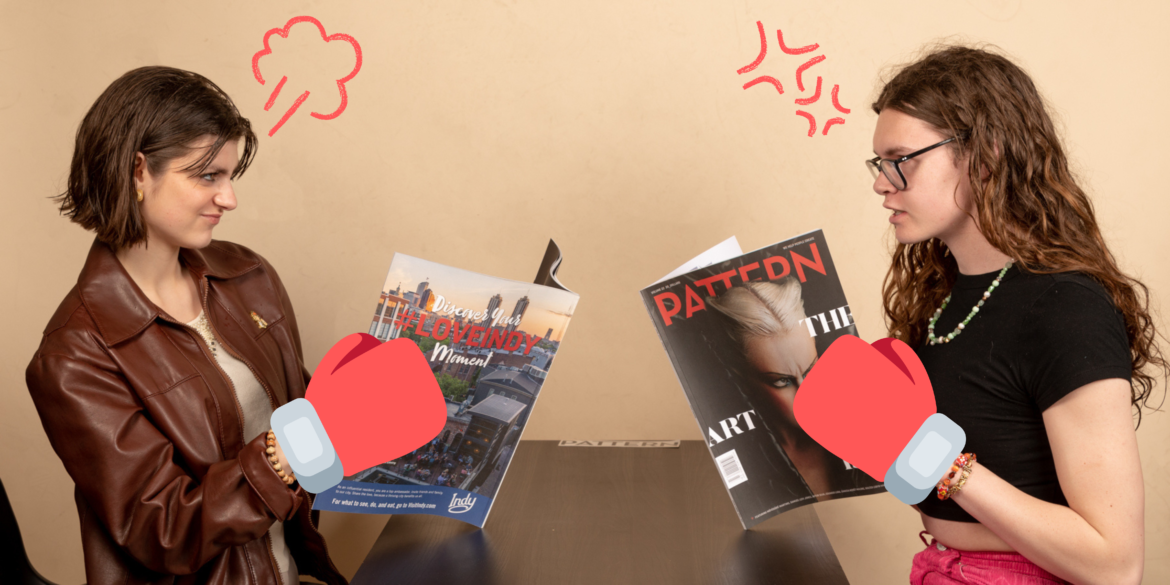Hey! You’re here just in time to witness the publishing industry’s fight of the decade. Self-publishing is currently taking on the undefeated all-time-record holder that is traditional publishing and is rising in the ranks. For what feels like forever, traditional publishing has been the only realistic option for writers to get their work published. However, with the rise of social media, self-publishing has never been more accessible. So, place your bets, do you think that self-publishing has what it takes to eventually dominate the publishing industry?
Girl, what?
It’s difficult to pick a winner if you don’t know who your fighters are. Self-publishing is quite self-explanatory: it’s when you publish your work yourself. Traditional publishing is *deep sigh* more complicated than that. The short version is that instead of publishing your work yourself, your work is published by a publishing house. Yet, in most cases, it doesn’t work out that you send your work to a publishing house and they just publish it. The publishing industry is far too competitive for that. Instead, you first have to send your work to a literary agent who may or may not sign to work with you. If they do accept your work, then they will market it to the publishing houses who, again, may or may not sign to work with you.
Much like the importance of strength, agility, and stamina in a fight, when it comes to choosing between self-publishing and traditional publishing, you have to consider the creative freedoms, labor, and profit that go into each. For the longest time, traditional publishing had self-publishing in a chokehold on the labor and profit front; however, self-publishing is now making a comeback because social media has become a gateway for self-promotion. Services like Kindle Direct Publishing, PublishDrive, and IngramSpark have made publishing your own work more convenient, effectively evening the playing field.
Local Indianapolis author, H.B. Louise, self-published her first novel Remembering in December of 2020 using the self-publishing service IngramSpark. Louise shared with PATTERN that “IngramSpark allowed me to have my book everywhere. It’s print-on-demand, so if a company wanted to sell Remembering, there’s a barcode that they could scan and get as many copies as they want to a shop or to an online store.”
Louise’s path to publication journey differs from another Indy-based author, Michael Dahlie, who has published several novels through a traditional publisher. Dahlie describes publishing his second novel, Best of Youth, with publishing house W.W. Norton as easier than the typical traditional publishing experience. This is because of something called an “option,” which some publishers offer. After publishing his first book with W.W. Norton, they offered him the opportunity to potentially publish a second book with them. An option is flexible on both ends, meaning that either party could have declined the opportunity. Dahlie says that he chose to pursue the option with the same publishing house because “I had an editor that I’d worked with that I loved, and I love W.W. Norton, so it was an easy setup.”
For authors who plan on traditionally publishing their first novel, the process is more tricky than above. In order to get a manuscript to a publishing house, a literary agent is needed to advocate for it. Much like applying to college, the writer sends their manuscript and cover letters off to several literary agents. Then, they wait to hear if their work has been accepted or not. If a literary agent accepts their work, they will try to sell the manuscript to a publishing house. If the literary agents reject their work or are unable to sell it to any publishers, then the author is tragically back at square one.
Miss Creative Independence
So now that you know your fighters, it is time to view their stats, starting with the creative freedoms that come with self and traditional publishing. When publishing a book, not only is the work itself a creative piece, but the cover art, formatting, marketing, and editorial edits are all creative aspects to consider.
For Louise, the creative freedoms aspect played a large role in her decision to self-publish.
“I knew that for me this was more of a passion project,” Louise says. “It was a goal of mine at least to get [my book] published and it was one thing to be able to say that I did it myself, instead of having somebody else touch it and change it. I didn’t want my book changed and if I went to a publishing company and got an agent, I didn’t want them to alter the storyline. At least for my first book, I wanted it to be me.”
Despite the publishing house having the final say, Dahlie felt like pursuing the traditional publishing route didn’t infringe on his creative choices.
“I had a wonderful agent for these books and he did not do a lot of editing,” Dahlie says. “When my book went to the editor, she did some edits but not much. The editor would ask for changes that either made perfect sense to me, or they didn’t and I could explain very clearly why I didn’t want to make the change.”
Now, while it may bother some, the art side of traditional publishing can also be beneficial (or at least not aggravating) for authors. Dahlie says “I also loved the cover so much that they presented to me for Best of Youth, which is the upside of working with places like W.W. Norton. They can hire super-talented artists who have devoted themselves to thinking deeply about the nature of images and words and how images appear on book covers. So, I suppose if I had really thrown a fit, I could have had that cover changed, but it was really terrific and there wasn’t much for me to complain about.”
The Grind
The next aspect to consider is the labor that goes into publishing. Many things like executing design, coordinating production, and managing a marketing campaign require labor and have to be done before a novel can be published, which can eat up a lot of time and energy. If you self-publish you have to take all of those tasks on, while if you are published traditionally, the publishing house will handle them.
While she was a full-time student at Butler University, Louise had to make time to prepare her novel for her deadline. For her, the hardest part was finding the discipline and motivation to push through the self-publishing process, while also balancing upper-level coursework and an internship.
“It was so challenging, I would wake up at five or eight in the morning and I’d stay up ’til one in the morning,” Louise says. “In the end, I found the time because I gave myself a goal and I knew that I had to get it done. Discipline was the hardest thing because it’s very easy to delay a task and say that it’s too difficult. There were so many times when something didn’t work out and I’d have to do it again, but I kept on pushing myself to the end.”
Though Dahlie’s publisher took point on production and marketing, that doesn’t mean he got to kick up his feet and relax. In reality, there are still tasks for authors to do to help the publishing house with the marketing campaign for a novel. Dahlie notes that in addition to brainstorming with the marketing team, he also makes an effort to stand out to companies and editors by writing them letters, making sure to tie in any personal connections when he can.
“People are pretty receptive to any kind of connection,” Dahlie says. “Outside of writing letters, you also have to do a lot of readings. It’s a standard experience for every writer I’ve ever known to show up at a bookstore and there are three people there for your reading. People who have sold millions of books have had that experience.”
$$$
Last but not least: the big bucks; the profit aspect of publishing. As our besties in accounting would tell you, profits are calculated by subtracting expenses from revenue. This means that when we consider the profit aspects of both self and traditional publishing, we have to consider how much it costs to publish and how much money you can make from publishing.
When it comes to self-publishing, since the author is publishing the novel themselves, they will receive the lion’s share of the revenue. Most avenues of self-publishing lead to the author receiving 100% of the revenue, or in other words, royalties. However, some of the new self-publishing assisting companies like Kindle Direct Publishing and Apple Books can take anywhere between 30-40% of overall royalties on top of production costs, while others like PublishDrive and IngramSparks charge upfront fees included with the cost of production. Alternatively, when it comes to costs, the majority—if not all—of that falls on the author. These costs can be anything from cover art to marketing campaigns or editors. While Louise was able to utilize her own resources to develop the cover art and marketing campaign for Remembering, she did have to shell out the big bucks for an editor. She used a company called Reedsy where she could connect with potential editors. After meeting with many different candidates, she finally found an editor whose style jived with hers.
“It’s all about finding someone that you can work well with,” Louise says. “It is also weird because you’re obviously looking at the price too. You don’t want to spend an arm and a leg, but you also want your personalities to mesh well. As I was submitting the payment through this website, I hoped that it would all work out, because you never know, and it went fine.”
The routes to revenue and costs in traditional publishing look very different than self-publishing. First, many authors receive most of their revenue from their advance, which is a larger sum of money that the publisher gives the author when the novel is initially picked up. Additionally, the author has to share a decent chunk of their royalties with the publisher and other contributing parties. Dahlie explains navigating how to earn a profit via the traditional publishing route:
“The goal is to make your advance back. After you make your advance back, the books you sell will [generate] a royalty. A lot of the numbers in royalties tend to be similar across books. Then, the literary agent fee or cut is usually 15%. I think that’s pretty standard. There’s usually not a lot of negotiation over that. I think that is one of the big differences between self-publishing and traditional publishing. When you publish traditionally, you’re definitely not putting up any of your own money. The publisher is funding everything.”
Now that you have heard the pros and cons of both self and traditional publishing, do you think self-publishing will become as mainstream as traditional publishing? Which publishing route entices you the most?
If you found any of their experiences helpful, please show your Indy authors some love and support on Instagram!
H. B. Louise @booksbyhb
Michael Dahlie @MichaelDahlie




